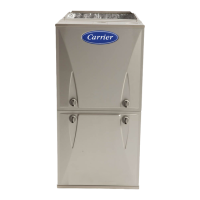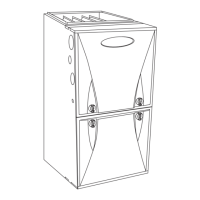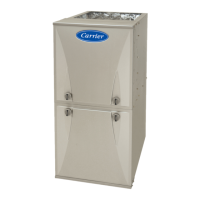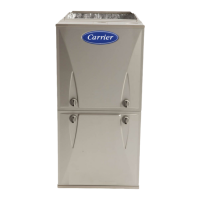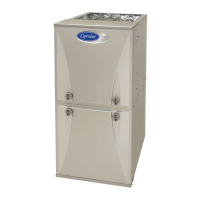59SC6A: Installation, Start-up, Operating and Service and Maintenance Instructions
Manufacturer reserves the right to change, at any time, specifications and designs without notice and without obligations.
58
Table 23 – Altitude Derate Multiplier for U.S.A.
To adjust manifold pressure to obtain the proper input rate, first,
determine if the furnace has the correct orifice installed. At higher
altitudes or different gas heat contents, it may be necessary to change the
factory orifice to a different orifice. Tables have been provided in the
furnace installation instructions to match the required orifice to the
manifold pressure to the heat content and specific gravity of the gas. To
do this:
1. Obtain average yearly gas heat value (at installed altitude) from
local gas supplier.
2. Obtain average yearly gas specific gravity from local gas supplier.
3. Find installation altitude in Table 25 or Table 26.
4. Find closest natural gas heat value and specific gravity in Table 25
or Table 26. Follow heat value and specific gravity lines to point of
intersection to find orifice size and manifold pressure settings for
proper operation.
5. Check and verify burner orifice size in furnace. NEVER ASSUME
ORIFICE SIZE. ALWAYS CHECK AND VERIFY.
6. Replace orifice with correct size, if required by Table 25 or
Table 26. Use only factory-supplied orifices. See EXAMPLE 1.
EXAMPLE 1: 0 - 2000 ft. (0 - 609.6M) altitude
Heating value = 1050 Btu/cu ft.
Specific gravity = 0.62
Therefore: Orifice No. 44
Manifold pressure: 3.4-in. w.c. (847 Pa)
(Furnace is shipped with No. 44 orifices. In this example, all main
burner orifices are the correct size and do not need to be changed to
obtain proper input rate.)
NOTE: To convert gas manifold Table pressures to Pascals, multiply
the in. w.c. value by 249.1 Pa/in. w.c. (1 in. w.c. = 249.1 Pa).
Check Inlet Gas Pressure
The inlet gas pressure must be checked with the furnace operating in
maximum heat. This is necessary to make sure the inlet gas pressure
does not fall below the minimum pressure of 4.5 in. w.c.
1. Make sure the gas supply is turned off to the furnace and at the
electric switch on the gas valve.
2. Loosen set screw on inlet tower pressure tap no more than one full
turn with a 3/32-in. hex wrench or remove the 1/8-in. NPT plug
from the inlet pressure tap on the gas valve.
3. Connect a manometer to the inlet pressure tap on gas valve.
4. Turn on furnace power supply.
5. Turn gas supply manual shutoff valve to ON position.
6. Turn furnace gas valve switch to ON position.
7. Jumper R and W thermostat connections at the furnace control
board.
8. When main burners ignite, confirm inlet gas pressure is between 4.5
in. w.c. (1125 Pa) and 13.6 in. w.c. (3388 Pa).
9. Remove jumper across thermostat connections to terminate call for
heat. Wait until the blower-OFF delay is completed.
10. Turn furnace gas valve electric switch to OFF position.
11. Turn gas supply manual shutoff valve to OFF position.
12. Turn off furnace power supply.
13. Remove manometer from the inlet pressure tap of the gas valve.
14. Tighten set screw on inlet tower pressure tap with 3/32-in. hex
wrench, or if 1/8-in. NPT plug was removed, apply pipe dope
sparingly to end of plug and re-install in the gas valve.
Adjust Manifold Pressure
NOTE: There are two manifold pressure tables in these instructions.
USE Table 26 FOR THE LOW CAPACITY 26,000 BTUh MODELS.
The low capacity model can be identified by the green label affixed to
the top of the gas valve. For all other models, see Table 25.
1. Adjust manifold pressure to obtain proper gas input rate. See
Fig. 65.
a. Refer to the correct manifold pressure table for the appropriate
model.
b. Turn gas valve ON/OFF switch to OFF.
c. Loosen set screw on manifold tower pressure tap no more than
one full turn with a 3/32-in. hex wrench, or remove the 1/8 inch
NPT plug from the manifold pressure tap on the gas valve.
d. Connect a water column manometer or similar device to
manifold pressure tap.
e. Turn gas valve ON/OFF switch to ON.
f. Manually close blower door switch.
g. Jumper R and W thermostat connections on control to start
furnace. See Fig. 38.
h. Remove regulator adjustment cap from gas valve pressure
regulator and turn adjusting screw (3/16 or smaller flat-tipped
screwdriver) counterclockwise (out) to decrease input rate or
clockwise (in) to increase input rate. See Fig. 65.
i. When correct input is obtained, replace cap that conceals gas
valve regulator adjustment screws. Main burner flame should be
clear blue, almost transparent See Fig. 64.
j. Remove jumper R to W.
A11461
Fig. 64 – Burner Flame
ALTITUDE PERCENT
OF
DERATE
DERATE
MULTIPLIER
FACTOR
*
*. Derate multiplier factors are based on midpoint altitude for altitude range.
NOTE: For Canadian altitudes of 2000 to 4500 ft. (610 to 1372 M), use
USA altitudes of 2001 to 2000 ft. (611 to 914 M) in Table 25 or
Table 26.
FT. M
0–2000 0-610 0 1.00
2001–3000 610-914 4-6 0.95
3001–4000 914-1219 6-8 0.93
4001–5000 1219-1524 8-10 0.91
5001–6000 1524-1829 10-12 0.89
6001–7000 1829-2134 12-14 0.87
7001–8000 2134-2438 14-16 0.85
8001–9000 2438-2743 16-18 0.83
9001–10,000 2743-3048 18-20 0.81
WARNING
!
FIRE HAZARD
Failure to follow this warning could result in personal injury, death,
and/or property damage.
Inlet pressure tap set screw must be tightened and 1/8-in. NPT pipe
plug must be installed to prevent gas leaks.
Burner Flame
Burner
Manifold
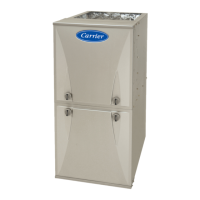
